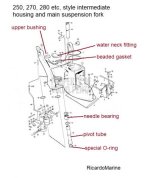Hi new to the forum this will be a little long I have 1983 wells wellscraft with an aq125a the problem was it was over heating in a tank with muffs on so far I have changed the inline neck on the outdrive, cleaned and flushed all the lines changed the fresh water impeller,thermastat, cleaned both fresh water and holding tanks took off the exhaust manifold and found a hole in the donut connecting the outdrive to the manifold and a leaking gasket put a new donut and checked the flow on manifold and everything looked fine installed with new gaskets. Still over heated li pumped the oil and found water checked compression all sitting at 125psi. Changed the head gasket and checked head it was not warped changed the timing belt as well . Check compression sitting at 155psi in all 4 and did a leak dow test and no leaks. Started up motor to retorq head and the motor started to heat up to 180 I shut it down I also been checking it with a temperature gun in case gauge was faulty. Problem I found water in the oil again not antifreeze I'm stumped and have no idea what to do can the manifold be cracked inside and pushing water into the exhaust valves thanks
Home
Outboard Motor Parts
Chrysler outboard parts Evinrude outboard parts Force outboard parts Honda outboard parts Johnson outboard parts Mariner outboard parts Mercury outboard parts Suzuki outboard parts Tohatsu outboard parts Yamaha outboard partsInboard & Sterndrive Engine Parts
Chrysler Marine inboard parts Crusader Marine parts MerCruiser sterndrive parts OMC sterndrive parts Pleasurecraft Marine parts Volvo Penta marine parts + MoreAll Engine Brands
All Manuals HomeOutboard Repair Manuals
Chrysler outboard manuals Evinrude outboard manuals Force outboard manuals Honda outboard manuals Johnson outboard manuals Mariner outboard manualsMercury outboard manuals Nissan outboard manuals Suzuki outboard manuals Tohatsu outboard manuals Yamaha outboard manuals
Inboard & Sterndrive Engine Manuals
MerCruiser sterndrive manuals OMC sterndrive manuals Volvo Penta marine engine manualsPlease Note
MarineEngine.com does not offer troubleshooting assistance or repair advice by email or by telephone.
You are invited to join our public Boat Repair Forum to seek assistance from other members.
You may also visit the Boat Motor Manuals section of our site to obtain a service manual.


